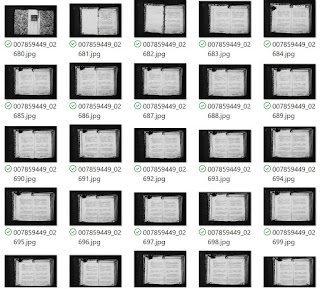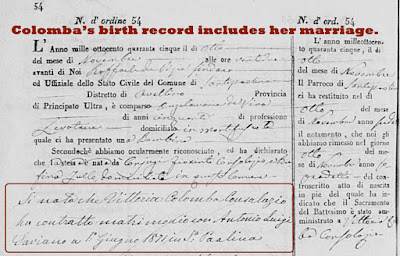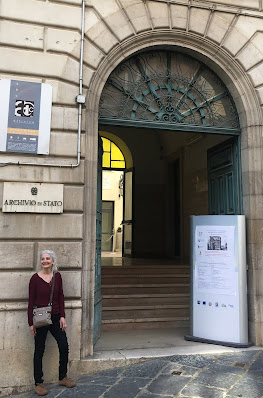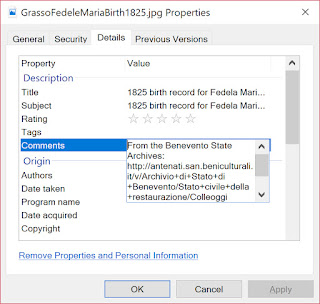"What? I never downloaded the 1940 census for my great uncle? Which other families haven't I gathered documents for?"
A Crisis With a Silver Lining
 |
| An 1899 birth record for my ancestor. |
I've written several times about my "document tracker" spreadsheet (see links at the bottom of this article). I use it to keep an inventory of every document image I've attached to someone in my tree. It's alphabetical by last name and has a column for each major type of document or fact. Birth, immigration, marriage, census, draft card, death, etc.
One of my 2018 Genealogy Goals is to "Fill in the 'Need to find' column" on my spreadsheet. That involves looking at which documents I've gathered for someone and listing what is still missing. For example, if I have the 1910, 1930 and 1940 census for a person, the 1920 census belongs in my "Need to find" column.
I hadn't spent much time on that, even though we're well into July. And then something went wrong. I noticed when I tried to re-sort the spreadsheet by the Person's Name column, a group of lines were being selected. It looked as if Excel was going to sort only those lines.
I use Excel every day on the job. I've never seen this happen before. I avoided sorting that day, but I guess I made a bad sort another day. This weekend I discovered the error. When I looked to see if I'd added the 1871 marriage record to my 2nd great grandfather's line, I saw all the wrong information!
It seems as if a lot of lines are off by one, containing dates for the person above them. The spreadsheet has 1,685 lines. I need to check them all!
Polishing that Silver Lining
Since I noticed this terrible problem while looking at my Saviano family, I decided to start there on line 1,464. I checked each line against Family Tree Maker to see which data belonged to whom.
To do this I clicked the Person tab, and then the Media tab in FTM. As a rule, I label all media items beginning with their date so they sort chronologically.
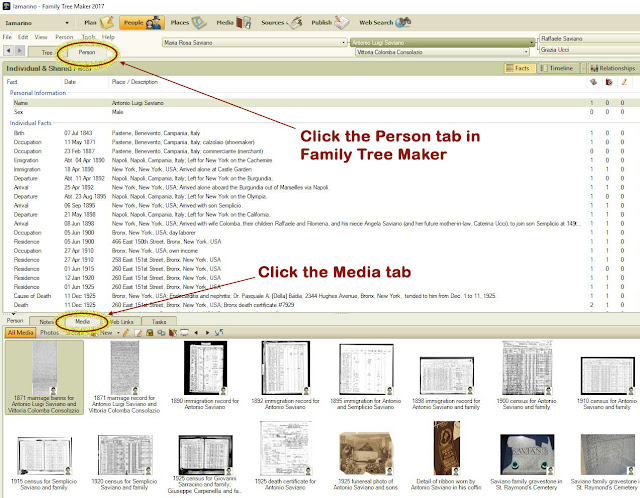 |
| I label each person's media files beginning with the date. Now they display in chronological order. |
I've recently gotten into the habit of adding "cert." to my spreadsheet when I have an actual certificate image. For example, in the Birth column it may say "1846 (cert.)". So I thought, why not add the person's birth year when I'm sure of it but have no document? I'll know there's no image because it doesn't say "cert." Those birth years are really helpful for telling my five Antonio Sarracino's apart!
And while I was checking each person's documents, I completed their "Need to find" column. As I finished each line, I gave the row a light green color. Now it's plain to see which lines I've checked.
I'm fixing any alphabetical-order errors manually to avoid future problems. When I add a new person, I'll have to insert a new line where their name belongs.
 |
| My document tracker spreadsheet holds my inventory and provides my task list. |
Two Birds with One Stone
If this sounds like a lot of work, it is, but there's a big payoff. As I'm working through the lines of the spreadsheet, certain things tempt me. I discovered I was missing an immigration record for my cousin's great grandparents. I noted that in the "Need to find" column, but then I decided to go get it. I found it on Ancestry.com. I put the date in the immigration column for both the husband and the wife, and took it out of the "Need to find" column.
Then I found people from Avellino, Italy, who were missing their birth records. The Avellino records became available last week! So I downloaded and added their birth records.
If not for this exercise, I wouldn't have realized I had Avellino people in need of documents.
The ultimate goal is to have all the lines verified and shaded green, and the "Need to find" column empty. That'll mean I've tracked down every major document I can for each person.
And if I can't find that 1940 census for my great uncle, at least I've got the ultimate short-list of what I need to find.
We all get side-tracked by lots of things. We're working with a new cousin to firm up our information. We're using new document collections to find lots more ancestors. We're trying to create trees to share with our family.
This exercise can get you focused on what you've left unfinished. I'm more motivated than ever to work on my document tracker spreadsheet. If you give it a try, I think you'll be happy you did.
Note: Be sure to read the follow-up article about using free Family Tree Analyzer for some of these tasks. Use This Tool to Discover Family Tree Insights.
Speaking of the document tracker:
